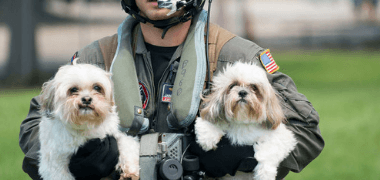Hurricane Irma has weakened to a Category 1 storm early Monday as it moves toward north Florida and Georgia over the next 24 hours.
As the storm is not yet over, forecasters have cautioned those in the storm’s path to prepare for dangerous storm surges and flash flooding. If you are a pet owner you must include your pets as well in your disaster plans, as they are members of the family.
Here are some safety tips from the experts at American Humane Rescue to keep yourself, your family and especially your pet safe if you are in the storm’s path.


BEFORE THE STORM
- Microchip pets or put a tag on their collar with your name, address and cell phone number so they may be returned quickly in case you are separated from your pets. Be sure that any microchip information is up-to-date.
- Tie down or anchor outside objects that might fly about and injure someone.
- Know a safe place where your pets can go if you need to evacuate or seek shelter. Evacuation destinations may include a friend or family member’s home, going to a pet-friendly hotel, or temporarily housing your pet(s) at a boarding facility. Plan multiple routes to your safe destination. Review your evacuation plan and double-check emergency supplies – including bowls, water, and food.
- Evacuate your family and pets as early as you can and remember to take your disaster preparedness kit for your pets (i.e. First Aid kit, leashes, and pets’ carrying cases, bowls, sanitation materials, chew toy, minimum 3 days, ideally 7-10 days of food, meds, water, your veterinarian’s contact information, a photo of your pet).
- Bring pets inside; bring outdoor animals inside with a carrier ready large enough to turn around and lie down comfortably.
- Have a carrier at the ready. The portable carriers(s) should be large enough for your pets to stand-up and turn around in ready to go at a moment’s notice. Practice loading cats and dogs in pet carriers before you have to.
- If your family must evacuate, take your pets with you.
DURING THE STORM (IF YOU CANNOT EVACUATE)
- Choose a safe room for riding out the storm—an interior room without windows – and take your entire family there, including your pets.
- Stay with pets. If crated, they depend on you for food and water. Don’t leave pets in vehicles.
- Keep your emergency kit in that room with you (food, water, litter, meds, etc).
- Know your pet’s hiding places. That’s where they may run; keep them with you.
- Secure exits and cat doors so pets can’t escape into the storm.
- Do not tranquilize your pets. They’ll need their survival instincts should the storm require that.
AFTER THE STORM
- Make sure the storm has fully passed before going outside and assess damages before allowing children or animals out.
- Keep dogs on a leash and cats in a carrier, and children close at hand. Displaced objects and fallen trees can disorient pets and sharp debris could harm them.
- Give pets time to become re-oriented. Familiar scents and landmarks may be altered and cause a pet to become confused or lost.
- Keep animals away from downed power lines and water that may be contaminated.
- Uncertainty and change in the environment affect animals, too, presenting new stresses and dangers. Your pet’s behavior may change after a crisis, becoming more aggressive or self-protective. Be sensitive to these changes and keep more room between them, other animals, children or strangers. Animals need comforting, too. Comfort your pet with kind words and lots of pats or hugs. If possible, provide a safe and quiet environment, even if it is not their own home.

